![[History]](http://us.yimg.com/i/ligans/cb/smtdih.gif)

Continued Transcription of interview 17/08/1995 with Rachel!
Re: - orphan in Castlemilk house 1961 - 1964.
Q 22. How could you get access to the isolation unit?
A 22. The isolation unit was the first bit you came to, before you went through the glass door.
You came up the main entrance and the isolation was off to the left, you came to the two
glass doors and that took you to the main reception, which was the main hall.
Q 23. Did the children go through the main entrance or was there another entrance for them?
A 23. That was only used for possibly the first day you were taken there. You would go through
there and would register and wait. Or if any visitors came then they would ring the bell
and that was the door that was used. Even visitors from John Street would use that entrance,
but apart from that everyone went to the side door.There was also a bit inside the house going
down the way, which brought you down to the side bit of the house. That was where you went
along and you had a sewing room for the sewing lady and you could still go further down again.
Q 24. Would this part of the house be the cellars?
A 24. At that point no! You were just on the bottom level. You had the sewing room, and this
is where the dining room was and the kitchen and a storeroom where they kept the soaps
and all that and a big square area where they kept all the prams. The dining room was for the
main part that was the main dining room. The children that were in isolation ate in isolation.
The meals were taken up and they had little tables. It was a little bit like a hospital ward.
Q 25. Do you think that you had seen most of the house during your stay there?
A 25. Yes, definitely. One or two of the windows I�m not too sure of but if I really think about it,
yes, I�ve been in most of the house. There were one or two staff rooms that I haven�t been
in where the members of staff stayed.
Q 26. So were there rooms under the house like cellars?
A 26. Downstairs there was a room that was locked and we knew that was things that people
had handed into the home like gifts, new things. When it was your birthday you were allowed
to pick something. It was quite spooky; you used to run through that bit. It was always locked.
They used to keep the Easter eggs etc. in there. Then you had the boot room; there was
also a laundry. There were big machines. That was also to the back of the home,
looking on to the pond. I wasn�t really in there that much.
Q 27. Was the laundry room at the back of the stables ever used for the home?
A 27. No, I didn�t know anything about that. We never used the Stables Block at all. (Architect)
Q 28. Was there any part of the grounds that were out of bounds to the children?
A 28. We were to stay within the railings of the grounds. Then there was the baby unit that
was round to the other side, which you weren�t really supposed to go, but the older girls
would maybe hear of a little baby coming in and you wanted a look or a baby that was
abandoned and you wanted to see it.
Q 29. Did you ever go on holiday or day trips with the home?
A 29. Yes. Your holiday was to another home; it was a nice holiday. We went to
Dunclutha, in Dunoon and there was a nice Matron there. They took in about 20 or 30
children. You were there for about 2 or 3 weeks. This was your summer holiday.
Matron Weir, I think her name was. I think that home is still there!
Our day trips were with the taxis on a yearly basis and they were brilliant.
They came with their taxis all decorated. I think they took us to Troon and I think they
took us to a church hall if it was raining. When we all came home again, all the children
were handed a shoebox and in it were a halfcrown and loaded with sweets.
Remember the room that was locked downstairs! That all went in there.
We didn�t get to keep it, but I think it was handed out bit by bit.
Q 30. Do you remember any Christmas�s there?
A 30. Yes. What you had to do was put your pillowcase out on the bottom of your bed
and there was always stuff in it. The older girls would maybe get jewellery and clothing.
I can�t really remember. It wasn�t wonderful, but it was OK.
Q 31. What like were the Christmas dinners there? Was it a big giant table?
A 31. I don�t remember that at all, no.
Q 32. Did you have much bother with nits?
A 32. Every Friday you had your hair bone combed and if it was discovered that you had
nits, they put vinegar on it. But if there was lice, then they put lorexine on it and it
made your hair greasy, you had to keep that on for a week. So you went from one Friday
to the next to school like a fish supper. Everybody knew and the smell was terrible.
Q 33. Did they take handicapped children in the home?
A 33. No, but in saying that, there was one family, I think there was four or five of them and
the eldest of them � Moira, was mentally handicapped as far as I believe she�s still in
Lennox Castle. Moira, was the same age as me. She went to a special school.
There was a grey bus came to take her to school. She was a lovely girl.
She and her brother ans sister stayed in the home for a while,
then they fostered her brother and sister out up north and it was a disaster.
The mum had died and the father had been killed in a motorbike accident and Steven
(Moira�s brother) was about 4 or 5 when he came into the home, he was the youngest and
Moira the eldest. Moira was in my bedroom, she was really great, she must be about
45 years of age now. (Interviewed 1995). I think she suffered from cerebal palsy,
although they didn�t call it that then. She would go into a little dream and be tensed up,
then squeal out and laugh and her head would swing to the side, she would sing
herself a little song. But there was no way she would have got adopted and the rest of the
family up back in the home.
There was another girl at one point, her name was Margaret, she was mentally
handicapped not physically and she went in the grey bus. She was only there for a
short while and I don�t know what happened to her. They tried to place them as best as
possible, because maybe some of them who were catholic went to catholic homes.
Q 34. Can you remember what the routine of a typical day was like?
A 34. We got up at 7.00am, made our beds, got dressed etc. The night staff would be on till
about 8.00am. The older children if it was needed would go down and help the staff
with the beds. Breakfast would be about 8.00am in the dining hall and I think that was
when the change over of staff would take place.
There was one sitting at breakfast and there were small tables for the ones under five.
It was just like dinner school.
Q 35. Was the dinner brought to the table?
A 35. No. You all had to go up and get it. It was porridge every morning, except Sunday�s
that�s when we got cereal. I never ate porridge of fish until I was about 37 years of age,
because if you didn�t eat the porridge at breakfast, then it would be waiting for you when
you got back from school, so it was better to eat it in the morning. The wee ones would
be spoon-fed in their high chairs and often they just threw it up again and you know
what kids are like. That made me feel that there was no feeling there, with some
of the staff, but I suppose it was their job!
Q 36. We believe that some of the staff who worked in the home had sometimes taken
home a few kids at the weekends! Is that True?
A 36. Yes, It was often that a member of staff would take somebody out.
Q 37. Did that ever happen to you?
A 37. No. I never went out in that sense, but I told you that my two brothers were working
and my eldest brother was working for British Telecom and he had a colleague that was an
older woman, so you know how you get talking! He told her that he had a little sister in
a home, so she used to take me out sometimes. I remember she took me to the ballet.
She would phone in and got to know Matron and said �I�ll take Rachel on Friday night
and I�ll bring her back�, that wasn�t over night, she would put me on the bus to get back
or she would bring me back herself. I remember on one occasion, one of the staff
had taken me to the Tattoo, in Edinburgh and I stayed overnight with her.
I also got very friendly with the sewing lady, she was an elderly lady and she stayed in
Rutherglen. I think she�d taken a shine to me and she asked if she could take me out,
but she stayed with an elderly friend, so it was like two old ladies. At the beginning it
wasn�t too bad. I�d stay out on the Friday and come back on the Saturday.
They were quite elderly and they meant well but at the same time, it wasn�t ideal.
I used to say �can I bring a friend with me�. But they did their best.
Q 38. Did your brothers come to visit you in the home?
A 38. A few times. We did keep in touch, but as I got older and nearing the time for me to
leave, my brother did phone up and ask if I could go and stay in the digs, or we�d
have an afternoon out. Matron would agree to that.
That was a treat. At the beginning, when I went into the home, my mother was still alive.
She was in Robroyston hospital and of course I wanted to go and see her.
They were quite good at giving me a weekly visit; one of the staff would take me.
I still have my mother�s letters; she used to send a letter nearly every week.
The staff was certainly good to me at that point.
Q 39. Did they have a lot of toys etc.?
A 39. Yes there was a playroom downstairs as well. It wasn�t massive but it was a playroom.
You also had a locker and everything you had in that was your own.
But the toys were shared. I remember on an other occasion when my mother
died I was allowed to go to the funeral. My aunt came down from Dundee for the
funeral. She�d given me twelve new shiny pennies, they were just out the bank and
I remember I�d brought them back to the home and I�d had them for a couple of days.
Then I�d put them in my locker. One day I came home and they�d gone. It had to be a
member of staff because the only children in on the day they�d went missing were the
under five�s. And under five would have shown everybody them. I remember going
to Matron and saying, �My money�s away�. And she said, �oh you must have spent it�,
but I hadn�t, so theses things did go on.
Q 40. Was there really bad staff in the home?
A 40. I wouldn�t say that there was any that was physically cruel or anything!
Q 41. Did they have any sort of punishment?
A 41. Yes. It would mean � early to bed and no television. But I didn�t see any physical
punishment going on. If you got sent to Matron�s office you knew that was enough.
If you didn�t eat your meals, you had to come back and eat it later when it was cold.
They had what they called the pigs bin under the table, so I didn�t understand why they made
you eat everything.I suppose there was unhappy times, because when my mother died.
I remember thinking, 'oh I�m going to be here till I�m 15 years of age.
What am I going to do'? I was thirteen when my mum died.
Q 42. How did you cope after your mother�s death?
A 42. I was all right; it was the night of the school dance (Glenwood), which was in the
December. It was my first school dance. My mother had actually died while I was at the
dance. Matron didn�t tell me until the next morning. My brothers came to the home
that day etc.I still wondered after that why they kept me there! And why I wasn�t
fostered out to a family. Because after all it was only a receiving centre!
Q 43. Do you think that they keep records of that far back?
A 43. They should. There was a Mr Ian Fyfe, from John Street. Who used to come out to the
home, he actually stays up in Bailleston. And I wonder if I could ever get talking to him!
Q 44. Would you for your own interest like to find out more now about your old records of
being in the home?
A 44. Yes, I would like to meet up with some of the old staff of the home.
Q 45. Did you get pocket money in the home?
A 45. Yes. On a Saturday morning. One shilling (I think) and we spent it in the wee shop at
Machrie. If you wanted to keep it then they kept it for you and added it on to your
savings. We went up to Matron�s office to collect it, then it was ticked off the sheet.
Q 46. Did you ever go to the pictures?
A 46. Yes. We went to �The State� picture hall on Castlemilk Road, sometimes on a
Saturday a couple of staff were always there.
Q 47. When you made friends in school, were they ever allowed to visit?
A 47. Saturday�s and Sunday�s were visiting times, but that was only for family'�.
Sometimes if the parents turned up drunk, they were sent away. I think that was very sad.
I was lucky I didn�t have that problem.The last time I�d spoke to �Moira Gillies� was in 1970,
and I vaguely remember her saying that the House had come down or was coming down.
I went to visit her once in Craigdhu, when she was the Matron and it was her that told
me that it was costing �50.00 a week to keep a watchman in it. At that time it didn�t really
bother me that the house was down because you have to get on with life.
Q 48. Did you ever remember getting photographs taken in the home?
A 48. No, but I�m sure they did.
Q 49. Did you ever do anything at Easter?
A 49. Yes. We went up the Cathkin Braes to roll our eggs. I remember there was one
Great big egg donated into the home and it was so big and thick that they had to break
it with a hammer. They used to lock it away.
Remember I told you about the fire escape beside my bed!
Well that led you into the kitchen, and let me tell you � �Ice cold milk was lovely
and it was bottled�. So it was hard to get rid of them, we used to throw the bottles in a
corner � I�m sure the staff must have found them.
We went to swimming on a Saturday and the kitchen was closed on a Saturday.
Cook had a day off, so what you got on a Saturday was the bread and butter was
out on the table and you got cheese and an orange or an apple, because you went
to swimming they didn�t want you to get cramp.
Q 50. What swimming baths did you go to?
A 50. Paisley swimming baths. We went on one of those big double decker�s
that threw you around. The Salvation Army came once or twice a year to play in
the grounds for us.At one point the assistant head of the school,
Miss McKellar, who always spoke up for us, arranged something at Inverclyde
Sports Complex. Some of the pupils in the school were already going and Miss McKellar
asked Matron if I could go. I went with a girl called Olive Barr, who stayed in Castlemilk
and later went to South Africa. She was going to Inverclyde, her parents were sending her,
I think it was for about 3 weeks.
Q 51. Did you have anyone come into the home to entertain you?
A 51. Yes. You would get people come in to do concerts, and singing etc.
Q 52. Was there a trained nurse all the time in the home?
A 52. I think there was always one, a staff sister or something like that.
I was not too aware of that. The Matron or Sister Gilles herself did have qualifications
because she had the uniform with the badge and the white hat and the navy tunic with
white. All the children did call the staff nurse even though they weren�t nurses. They
were only ordinary people. They were just staff. At any point they could call a doctor in if
you weren�t well. I remember not being well, they put me to bed and called the doctor to
check me over. The hairdresser came in every six months and we all got a hair cut.
Q 53. Were the haircuts severe?
A 53. Well, the boys would have short back and sides and the girls would have �
like the bowl round the head.
This ends the interview with �Rachel� on 17/08/1995, At the Birgidale Complex in Castlemilk.
By the Castlemilk History Group.
Some of the Photographs belong to the following web sites - 1 - 2 - 3 - 4
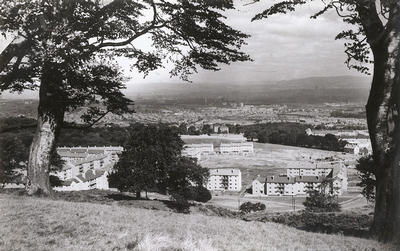


(at Castlemilk) from
Jersey, who were sent to Castlemilk House
During the second world war.
(unknown source and date)
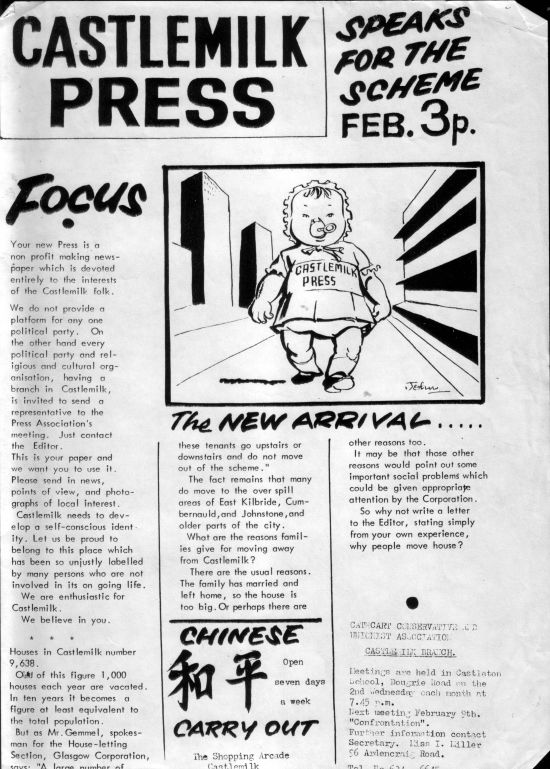
Castlemilk Press.
Date Unknown! Approx Early 70's
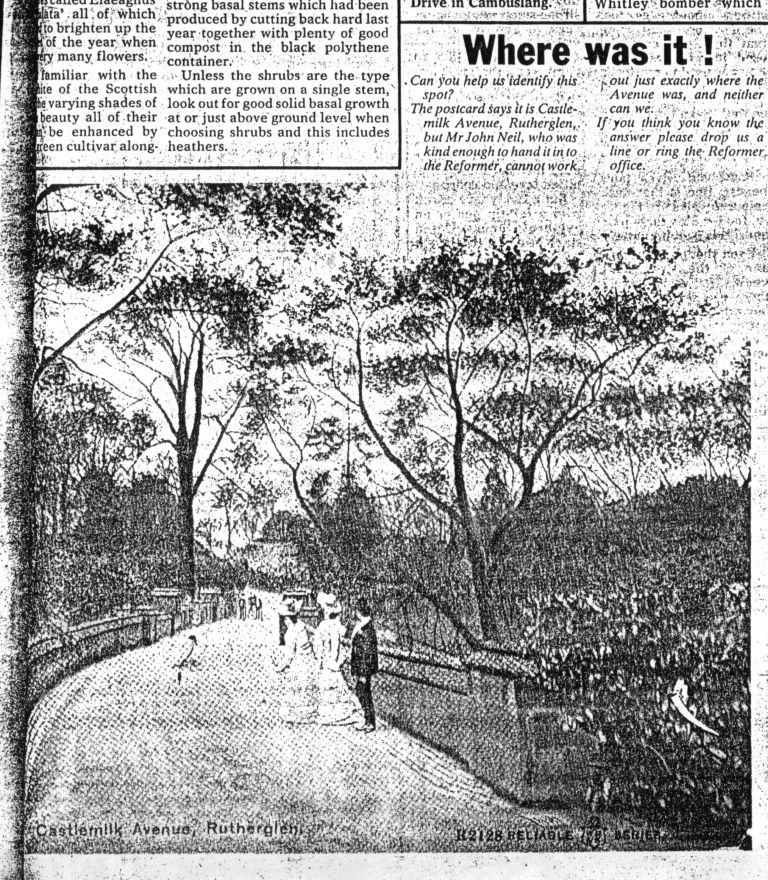
The Rutherglen Reformer in 1981.
To guess where the picture was taken.
We now know it was:-
Castlemilk Bridge - Over the pond.
It Is called "Castlemilk Avenue"
at the bottom of the picture
(Date - Unknown).
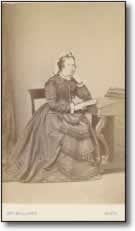
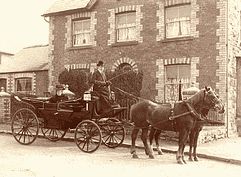
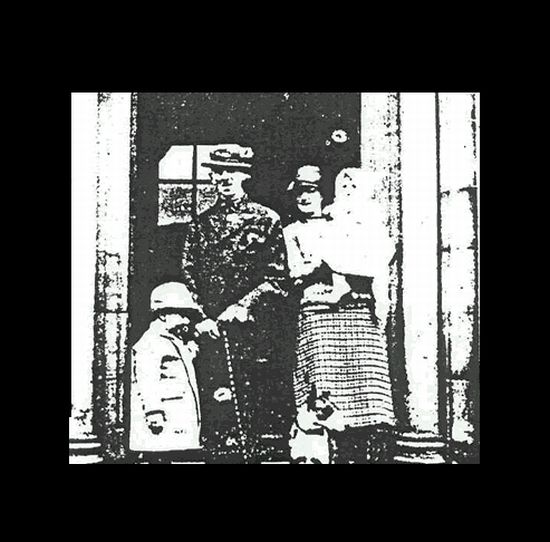
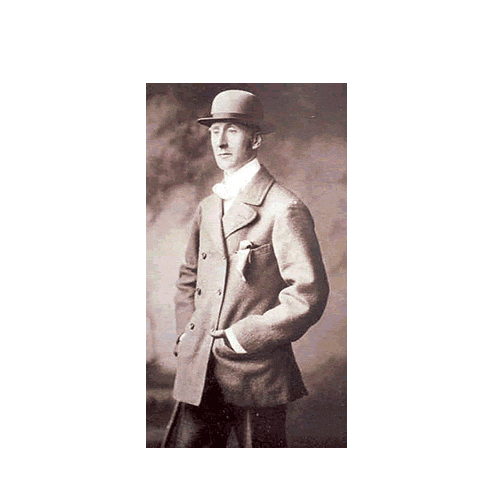
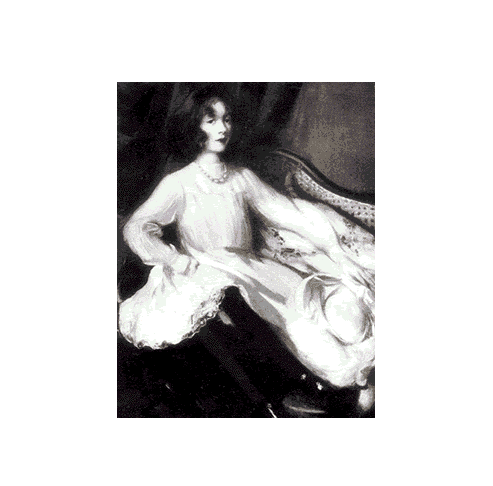
'Helen Is My Name'
written by
The Baroness of Kilbride
Written by
The Baroness of Kilbride
Lady Helen Constance Stuart
(Daughter of Last Laird of Castlemilk)
Privately Printed 1968
At Castlemilk near Glasgow, in the Lowlands of Scotland � October 17th 1896 the clock struck five, the bell rang for tea and I made my bow to world, �roaring like a bull� so my father said.
I weighed 10lbs so my little mother must have had a grim time. As I continued to �roar� for the first night of my life, I was banished to a spare bedroom as far from my mother as possible.
The first important event in my life was when I chose my own Christian name. My parents could not decide what to call their much hoped for daughter,
torn between the family names of Margaret, Helen, Katherine etc.; so all the names were put into a hat and my infant hand was thrust in.
I managed to grasp the slip of paper on which was written �Helen Constance�, and so it was.
My brothers and I were taken care of in our Nursery, with three nurses to look after us. Mrs Dykins, the head nurse, who had the prefix �Mrs.� As a courtesy title to denote rank,
was called Nanny by the children and family. There were two under-nurses: Charlotte Huppert, also �Mrs.� As she had been my eldest brother�s �wet nurse�.
In other words she was that ancient figure, known from earliest ages as a Foster Mother�. This woman, having more nourishment than was necessary for her own baby, could nurse another.
In the late Victorian days of which I write, this was a favoured way, amongst those who could afford it, of brining up a delicate baby. The other under-nurse at that time was Rose.
All three dressed in white, starched, pique dresses, and all wore lace caps on their heads. Nanny had a fresh white dress every two days and of course all wore large white aprons with bibs.
When going outdoors, grey coats and skirts were worn and black straw or felt hats according to the season.
Compared with my two well-behaved brothers, I must have been a sore trial to Nanny, and a broad white satin belt always adorned my waist,
so that she could catch hold of me and perhaps cane my hand!
My father (The Last Laird of Castlemilk) was born 9th May 1854 in Dublin. He was accompanied into this world by a twin sister, �Anne Margaret Helen.
My father was named after his grandfather, father and uncle � William James Stirling Crawfurd � Crawfurd Stirling Stuart.
The first few years of his life were spent in Ireland, where his father was soldiering. On my grandfather�s retirement from the army, they went to live at Castlemilk.
My father was educated privately until he went to Cambridge University. Thanks to his uncle Stirling Crawfurd and William Stirling of Keir, who paid the fees, he went to Trinity College, Cambridge.
My mother � Constance Marie de Lormet Dennistoun was the fourth daughter of Alexander Dennistoun of Golfhill. She was born on the 6th January 1859 and was the
most typically French of all the six daughters and the smallest being only five foot six inches, with dark brown hair, hazel eyes, the most wonderful complexion, thin straight nose,
curved sensitive mouth and beautiful little teeth.
She moved with elegant grace and was always most perfectly dressed, with never a pin out of place. My mother was thirty�two when she married, which was very late in those days.
I never saw my dear little mother lose her temper and she was the most wonderful mother a daughter ever had. My little mother loved snowdrops and there were sheets and sheets of them at Castlemilk.
I always brought her the very first, from those clenched in my baby hand till the last ones I placed in her coffin, as she died in snowdrop time.
Her grave was lined with them, those darling little flowers, the first heralds of spring and of hope. After her death and according to custom the family pew in Carmunnock was heavily
draped in black which stayed on for at least two years because of my father�s deep grief.
My mother�s elder sister �Augusta Caroline Georgina Dennistoun (Aunt Ga-Ga) often stayed with us at Castlemilk, several times during each year and more often when my mother died.
I was devoted to her. In the summer holidays when we were young she would rush around playing hide-and-seek with us in the garden at Castlemilk, her long black skirts flying out and
her slim black-stockinged legs racing along while she held on to her black hat. remember one episode, when she, over fifty years of age, climbed into the cart,
which was full of grass-cuttings from the lawn-mower. There she and I lay prone, while my brothers sought us, until the garden-woman betrayed our hide-out.
I do not think my aunt ever forgave her.
She was at my wedding and the christening of Jimmie, and deeply loved our two children. I was with her in London during her last illness, when to my amazement she expressed
to me the wish to be buried at Carmunnock and not beside her husband, who, she pointed out, lay beside his first wife. She had even selected the grave,
which was the one my grandfather had occupied before being moved into the family vault. She said she wanted to be close to us (we then all lived at Castlemilk) and she asked that
my children would trample on the grass of her grave with their little feet. Her wish was gratified, even to Jimmie�s remarking one day, �Poor Auntie Ga-Ga under the grass�.
Let me describe a typical Sunday of my childhood. Breakfast in the nursery at 8.30, self wearing white, embroidered, starched cotton frock.
Breakfast consisted of porridge, egg and bacon. This meal was prepared by Nanny. My porridge was smothered in rich Jersey cow cream of which I was extremely fond.
The porridge plate was white, and had a large and fascinating blue goat on the bottom. After Breakfast, this and every morning came �The Reading�.
This consisted of Nanny, sitting at the breakfast table with her spectacles on and her well worn bible in her hand, reading aloud a few verses.
On Sundays I had to learn by heart a psalm or a paraphrase; these are used in the Scottish Church and are in metre .
Only when word perfect, which actually did not take long as I had a very good memory, were my curl-papers removed, my manufactured curls combed out,
face and hands washed again, and I was allowed to go to the dining-room where my parents were having breakfast.
This was by now 10 a.m. was always given some fruit and climbed on the chair placed for me.
Getting ready for church was agitating. We attended the Scottish Church in Carmunnock, our small village about two-and-a-half miles away, except on Church Festivals,
when we drove into Glasgow to the Episcopal Church of St Ninian�s, where I was christened. I always had the most gorgeous clothes, carefully thought out by my mother to show off my
bright red hair and, dressed in my Sunday best, I followed her into the closed carriage, which was like a cab and drawn by a pair of fine horses with
gleaming black harness and highly polished brass. The Coachman wore a heavy dark blue overcoat, with brass buttons which bore the family crest,
while the carriage-boy was a small replica of him and wore long trousers, to which were attached leather straps that passed under his boots thus
keeping them in position and without crease. Shiny top hats were worn by both.The butler and footman assisted my mother into the carriage and bowed us off,
and the coachman and boy saluted. We drove through the gates of the West Lodge and when the carriage was heard to approach, the lodge-keeper had to rush out and open the gate.
We swept through and up a farm road to the village.
As we entered, we passed groups of people making their way to church which was at the top of the village street and on a slight incline.
I would lean forward to wave to my friends, for we new practically everyone in the village. We now stopped at the high wooden gates leading into the churchyard, with its many graves.
The carriage-boy ran round to open the carriage-door and my beautiful little mother stepped daintily out, exquisitely dressed, and bowed graciously to everyone.
Immediately on the left, beside the high wooden gates, was a small stone house, called the Watch House, where, in the old days, around 1828, a man with a gun
sat by a small window, day and night, watching for �body-snatchers�.
These were men, who would raid cemeteries, dig up newly-buried corpses and sell them to medical students for dissection.
There was no watchman in my days, but the officiating elders, or Church-wardens, waited there till the service started and also stood
at the plate in which were placed the offerings. This plate was incorporated in a heavy metal stand which had stout metal feet and stood right in front of the entrance gate.
Alongside on the grass stood on enamel slop pail, with handle, and an enamel mug. Thirsty church-goers could dip the mug into the water-filled-pail,
slake their thirst and pour back into the pail any un-drunk water, so that none was lost.
Carmunnock Church is an ancient pre-reformation building. It has three outside stairs which lead to the galleries or �lofts� of the Church, which are respectively
�Cathkin Loft�, �Dripps Loft�, and �Castlemilk Loft�. It is the last-named one which we are now interested because I am four years old and it is my first time at Church.
My mother advances to the stone steps leading to our �loft�, with me clinging to her hand, and dressed all in white as she so liked to see me.
Behind walks Nanny, carrying a large pale blue silk-covered cushion to place at my back, in case I might fall through the open back of the chair in the Church!
We mount the dozen steps in two flights and go in at the wooden door. There is a small kind of entrance hall, with two doors, one leads directly into the Church,
the other into our Retiring Room, furnished like a sitting-room, with a fire burning in the grate in the winter,
and two windows, one of which has some of my aunts� names scratched on it with a diamond.We enter this room and wait for the service to start.
To pass the time we watch the congregation as they come in, naming those we know. We must not stand in the window, as that would be staring and rude, we must just peep from the side.
These Retiring Rooms, attached to the Laird�s pew, in most of the old Churches, were originally for the family to retire to and eat their luncheon between services,
as the first service started at noon and finished at 2 p.m. and the second began at 2.30 and continued until 4.
At the first strains of the harmonium, my mother opened the other small door leading right into the church and I trotted in by her side, leaving Nanny to close the door.
In the very front of the gallery was a row of seven chairs, an armchair in the middle with three hand-chairs on either side. My mother sat in the armchair and I next to her,
Nanny having deftly slipped the pale blue cushion behind my back. The chairs had seats covered with horsehair material and
this pricked the back of my knees unmercifully. Nanny seated behind our chairs on one of three wooden seats placed one each side of the two
entrance doors, and one in between the doors. The one on which Nanny sat had above it a brass plate in the memory of my grandfather. These three long wooden seats were assigned to the
gardener, the estate-carpenter, the laundry-maids, the Keepers and the dairy-man. The maid servants, butler and Nanny went to church in Rutherglen.
The first psalm was given out, my mother found my place in the old family psalm-book and we rose to sing.Before the singing was finished, the door of our room burst open and in strode my father,
having walked the two miles to Carmunnock. He always arrived at exactly the same moment of lateness.Apparently I behaved so well my first Sunday in the Church that Nanny did not come again.
During the holidays my brothers attended too, Jim sitting next to my mother and Rae next to me.
This was fatal, as he always tried to make me laugh and sometimes succeeded, which would draw frowns from my mother.
In the area of the church were the pews reserved for all our farm tenantry, and each family in the village had their own seat.
Our neighbours, the Findlays of Cathkin, had the pew next to ours and we were allowed to exchange smiles and of course talk on coming out of the Church.
The service was pretty dreary, Dr Gillian old and inclined to haver. Our great delight was to look for the carriage coming to take us home.
This was easy as there was a clear window on either side of the pulpit which our pew faced. We would nudge each other, Rae and I, as we saw our source of deliverance arriving.
Back at Castlemilk, the Sunday Inspection took place of the Stables and gardens. We entered the garden by its back entrance, passing the laundry-maids� cottage and the laundry.
We kept three laundry-maids, the Head, Grace Ostins, who was with us for over 40 years, and two younger girls, who moved on after serving their apprentice-ship under such a wonderful �Head�.
I feel it is permissible to state here that my father used fourteen shirts a week! Two a day, his coloured day one and his white evening one.
All these had starched fronts and cuffs which had to be polished and were indeed a work of laundry art!
The garden covered more than eight acres. There was the flower garden, a walled enclosure with three iron ornamental gates.
A large central grass plot was divided into most intricately ornamental flower beds, displaying the �Buckle Crescent� and �Star� of the family coat-of arms, all planted out in flowers.
At the end of this garden were the green houses, with grapes and peaches, the centre one containing palms,
ferns, etc. As the garden was entirely shut in my father found it most useful for exercising any new dog, as there was no means of escape. The rest of the gardens were mainly ornamental.
Two fine �monkey-puzzle� trees gifted by my Uncle Crawfurd were very rare in the 1860s. By the main gate, which led off the avenue, was a large yew-tree under which was buried the charger my
great-grandfather rode at the battle of Waterloo, but its name was never recorded. In front of this historic grave, a row of small tombstones marked the graves of my father�s favourite dogs.
Each had a headstone with the dog�s name, date of death and a small epitaph most carefully composed by my father, who was devoted to dogs and could make them do anything for him.
Having completed the tour of the gardens, we went through a small iron gate on to the farm road that leads up the Braes to the kennels, where the sporting dogs and gamekeepers lived.
It was quite a walk as the farm road ended at the foot of the steep hill or brae.Our Sunday afternoon�s work was over and the family procession wended its way down the Braes to the house.
I would have tea in the nursery and at six o�clock go to the drawing-room, where being pSunday, I looked at Biblical pictures, or photograph albums.
To be continued ----------------


